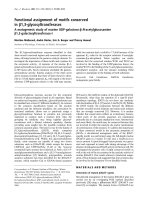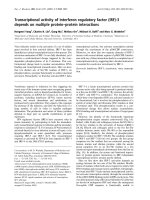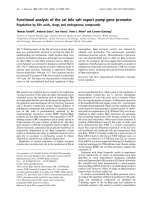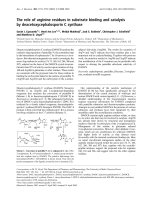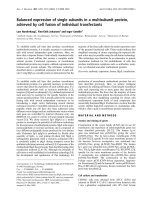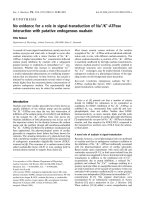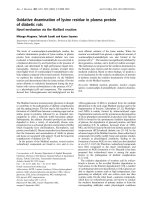Báo cáo y học: "No evidence of major effects in several Toll-like receptor gene polymorphisms in rheumatoid arthritis" pdf
Bạn đang xem bản rút gọn của tài liệu. Xem và tải ngay bản đầy đủ của tài liệu tại đây (160.16 KB, 10 trang )
Open Access
Available online />Page 1 of 10
(page number not for citation purposes)
Vol 11 No 1
Research article
No evidence of major effects in several Toll-like receptor gene
polymorphisms in rheumatoid arthritis
Olivier Jaen
1
, Elisabeth Petit-Teixeira
2
, Holger Kirsten
3
, Peter Ahnert
3
, Luca Semerano
1,4
,
Céline Pierlot
2
, Francois Cornelis
2,5
, Marie-Christophe Boissier
1,4
, Geraldine Falgarone
1,4
for the
European Consortium on Rheumatoid Arthritis Families
1
EA-4222, University of Paris 13, 74 rue Marcel Cachin, 93017 Bobigny cedex, Paris, France
2
Genhotel EA-3886, University Evry-Paris 7 Medical School, Member of the AutoCure European Consortium, CP5727, 91057 Evry-Genopole cedex,
Paris, France
3
University of Leipzig, D-04109 Leipzig, Germany
4
Rheumatology Department, Avicenne Hospital AP-HP, 93009 Bobigny cedex, Paris, France
5
Unité de Génétique Clinique, Pôle des Laboratoires Médicaux-Imagerie-Pharmacie, Lariboisière Hospital, AP-HP, 2 rue Ambroise Paré, 75010 Paris,
France
Corresponding author: Geraldine Falgarone,
Received: 30 May 2008 Revisions requested: 18 Aug 2008 Revisions received: 23 Sep 2008 Accepted: 13 Jan 2009 Published: 13 Jan 2009
Arthritis Research & Therapy 2009, 11:R5 (doi:10.1186/ar2589)
This article is online at: />© 2009 Jaen et al.; licensee BioMed Central Ltd.
This is an open access article distributed under the terms of the Creative Commons Attribution License ( />),
which permits unrestricted use, distribution, and reproduction in any medium, provided the original work is properly cited.
Abstract
Introduction The objective was to study the potential genetic
contribution of Toll-like receptor (TLR) genes in rheumatoid
arthritis (RA). TLRs bind to pathogen-associated molecular
patterns, and TLR genes influence both proinflammatory
cytokine production and autoimmune responses. Host–
pathogen interactions are involved in RA physiopathology.
Methods We tested SNPs of five TLR genes (TLR9, TLR2,
TLR6, TLR1, and TLR4) in a cohort of 100 French families with
RA. Genotypes were analyzed using the transmission
disequilibrium test. As TLR2, TLR6, and TLR1 are located on
chromosome 4, we determined the haplotype relative risk.
Analyses were performed in subgroups defined by status for
rheumatoid factor, anti-cyclic citrullinated peptide
autoantibodies, and erosions.
Results We found no disequilibrium in allele transmission for
any of the SNPs of the five TLR genes. In subgroup analyses, no
associations were detected linking TLR9, TLR2, or TLR9/TLR2
to rheumatoid factor, anti-cyclic citrullinated peptide
autoantibodies, or erosions. Haplotype analysis of the
polymorphisms showed no haplotype associations in any of the
subgroups.
Conclusions We found no evidence of major effects of TLR
gene polymorphisms in RA, although we tested different TLR
phenotypes. Moreover, no associations were noted with
autoantibody production or erosions.
Introduction
Rheumatoid arthritis (RA), the most common inflammatory
joint disease, exacts a huge toll of disability, deformities, qual-
ity-of-life alterations, premature deaths, and economic costs
[1]. RA is an autoimmune disease characterized by chronic
inflammation of the synovial membrane, which is infiltrated by
activated immune cells including CD4
+
T cells, B cells, and
antigen-presenting cells such as dendritic cells and macro-
phages. The factors responsible for RA induction and progres-
sion are poorly understood but may involve interactions
between innate and adaptive immunity [2]. It has been sug-
gested that viruses and bacteria may contribute to initiate or
exacerbate RA by binding to Toll-like receptors (TLRs). TLRs
are expressed by a variety of immune cells, including B lym-
phocytes and T lymphocytes, antigen-presenting cells, regula-
tory T cells and nonimmune cells such as fibroblastic
synoviocytes [3-7]. All of these cell populations are found in
the rheumatoid synovium. TLR ligands such as peptidoglycans
anti-CCP: anti-cyclic citrullinated peptide; IL: interleukin; PCR: polymerase chain reaction; RA: rheumatoid arthritis; RF: rheumatoid factor; RFLP:
restriction fragment length polymorphism; SNP: single nucleotide polymorphism; TDT: transmission disequilibrium test; TLR: Toll like-receptor.
Arthritis Research & Therapy Vol 11 No 1 Jaen et al.
Page 2 of 10
(page number not for citation purposes)
and double-stranded DNA are also present in the rheumatoid
synovium [8], suggesting that innate immunity may be involved
in initiating the inflammatory process or in inhibiting regulation
mechanisms that normally prevent chronic inflammation.
TLR gene polymorphisms have been tested in several cohorts.
A study of Asp299Gly (rs4986790) and Thr399Ile
(rs4986791) TLR4 polymorphisms in a cohort of RA patients
in Spain found no associations with susceptibility to RA [9]. A
case–control study of TLR4 Asp299Gly in a cohort in North-
ern England also found no association, even in the subgroup
of patients negative for the shared epitope [10]. Interestingly,
heterozygous Asp299Gly status was protective in early
untreated RA in a case–control study performed in The Neth-
erlands [11]. Finally, the Asp299Asp polymorphism was asso-
ciated with higher remission rates after treatment with
disease-modifying antirheumatic drugs, compared with the
Asp299Gly polymorphism [12]. The role for TLR4 in RA,
despite studies in various cohorts, therefore remains unclear.
The TLR2 polymorphisms Arg677Trp (no rs number reported)
and Arg753Gln (rs5743708), both implicated in susceptibility
to infection, were not associated with arthritis in a cohort in
Spain [9]. Of note, these two TLR2 gene mutations were asso-
ciated with reduced induction of IL-10 and IL-12 expression
after stimulation [13]. In mice injected with TLR2 ligands, reg-
ulatory T cells lose their regulatory capacities, suggesting a
role for TLR2 in regulatory T cell control [14]. Prolonged reg-
ulatory T cell stimulation by TRL2 ligands may therefore trigger
or exacerbate autoimmune responses. Studies in animal mod-
els have established that the TLR2 status influences the out-
come of adjuvant-induced arthritis and streptococcal cell wall
arthritis. Mice deficient in MyD88, the TLR adaptor molecule,
do not develop arthritis. Similarly, TLR2-deficient mice exhibit
lower arthritis scores [15].
As TLR1 and TLR6 are TLR2 co-receptors that increase the
number of ligands and induce different transduction pathways
[16-19], it was of interest to determine whether the TLR1 and
TLR6 genes showed polymorphisms that were linked to RA.
These polymorphisms have been studied in inflammatory
bowel disease [20] but not in joint disease. Studies have
shown that TLR1 Arg80Thr (rs5743610), Asn248Ser
(rs4833095), and Ser602Ile (rs5743618) SNPs are associ-
ated with invasive aspergillosis [21] and with Crohn's disease
[20]. The TLR6 Ser249Pro SNP (rs5743810) is associated
with a reduced risk of asthma and an increased risk of invasive
aspergillosis [21,22].
Transcription factors that bind to the TLR9 promoter region
include GATA-1, GATA-2, c-Ets, and CP2 [23]. In silico inves-
tigations indicate that the -1486 T/C (rs187084) substitution
probably creates an SP-1 binding site [24]. Nevertheless, nei-
ther this SNP nor TLR9 +2848A/G (rs352140) was associ-
ated with systemic lupus erythematosus in a cohort in Korea
[23]. In contrast, the TLR9 -1237C/T (rs5743836) polymor-
phism was associated with Crohn's disease [25] and with
asthma [26].
In the present article, we investigated potential associations
between RA and SNPs of TLR1, TLR2, TLR4, TLR6, and
TLR9 in a cohort of French Caucasian families with RA. We
elected to investigate a range of TLRs believed to interact with
viruses, Gram-positive bacteria, or Gram-negative bacteria.
We used PCR-RFLP and matrix-assisted laser desorption/ion-
ization–time of flight mass spectrometry to determine the gen-
otypes of 100 family trios, each comprising the index patient
and both healthy parents. We analyzed several subgroups of
severe RA that might be linked to TLR gene polymorphisms,
including the subgroups with rheumatoid factor (RF) or with
anti-cyclic citrullinated peptide antibody (anti-CCP), two RA-
related autoantibodies, and the subgroup with joint erosions,
since these are often associated with autoantibody produc-
tion.
Materials and methods
Demographic and clinical features of the study
population
RA families were recruited through a national media campaign
followed by selection of individuals who fulfilled the 1987
American College of Rheumatology revised criteria for RA. A
rheumatologist reviewed all clinical data. In each of 100
French Caucasian families, we studied one individual with RA
and both parents; to be eligible for the study, all four grandpar-
ents of the patient had to be European Caucasians. Among
the 100 RA patients, 87 were women and 13 were men; their
mean age at disease onset was 39.6 years, 72% were RF-
positive, 81% were anti-CCP-positive, 86% exhibited joint
erosions, and 90% had rheumatoid nodules. All study partici-
pants provided informed consent, and the appropriate ethics
committee (Bicêtre Teaching Hospital, Paris, France)
approved the study.
Molecular genotyping methods
Genomic DNA was purified from fresh peripheral blood leuko-
cytes using standard methods. To genotype TLR genes, we
performed PCR-RFLP analysis or single-base extension fol-
lowed by mass spectrometry.
For PCR-RFLP analysis, each amplification on each sample
was performed in a 35 l reaction volume composed of 10×
PCR buffer (Perkin Elmer, Boston, MA, USA), 0.5 M each
primer, 0.1 mM each dNTP, 1.25 units Taq Gold DNA
polymerase (Perkin Elmer), 3 mM MgCl
2
, and 70 ng genomic
DNA, diluted to the final volume with H
2
O.
Toll-like receptor 1
Three SNPs were genotyped for TLR1. SNP1 (rs5743618) is
a G/T polymorphism of Ser602Ile in exon 4 at position +7765
of the gene. SNP2 (rs5743594) is a C/T polymorphism con-
Available online />Page 3 of 10
(page number not for citation purposes)
stituting a noncoding mutation in intron 2 at position +3663.
SNP3 (rs5743560) is an A/C polymorphism constituting a
noncoding mutation in intron 1 at position +214; this SNP did
not exhibit sufficient polymorphism in the participants to allow
genotyping in the association study.
The primers used for PCR amplification are presented in Table
1. Conditions will be supplied on request.
Toll-like receptor 2
Five SNPs were initially chosen for TLR2. These SNPs were
rs1816702 (SNP1), rs3804099 (SNP2), rs5743708 (SNP3),
rs1804965 (SNP4), and rs4696480 (SNP5). SNP1 is a C/T
polymorphism that constitutes a noncoding mutation in intron
1 at position +458 of the gene. Primers used for the SNP1
PCR arepresented in Table 1. Conditions will be supplied on
request for all SNPs. SNP2 is a C/T polymorphism that consti-
Table 1
Comparison of SNPs in the present study with the literature (Reference SNP (rs) and PCR primers)
PubMed identifier Gene SNP reference Allele MAF
a
Found in the literature? PCR primers
Present study TLR1 rs5743618 G/T No Forward, 5'-
CCCGGAAAGTTATAGAGGAACCCT-3'
Reverse, 5'-
TTCACCCAGAAAGAATCGTGCCCA-3'
Present study rs5743594 C/T No Forward, 5'-
AAGATCAGGGTGGTAGTGTTGG-3'
Reverse, 5'-
CCCAATTCTTCCTCTCCAGCTT-3'
Present study TLR2 rs3804099 C/T No Forward, 5'-
ATCGTCTTCCTGGTTCAAGC-3'
Reverse, 5'-
CAGTTCCAAACATTCCACGG-3'
Present study rs4696480 T/A No Forward, 5'-
CAAATTTAAAAGAGGGCAAGAAA-3'
Reverse, 5'-
CAGTTTATTGTGAGAATGAGTTT-3'
Present study TLR4 rs2737191 A/G No Forward, 5'-
CATCCCCTACTTTCTTCACA-3'
Reverse, 5'-
TCAACTCAGGACCCATAATC-3'
Present study rs4986790 A/G 32%/32.50% Yes: other name Asp299Gly Forward, 5'-
TCTGGGAGAATTTAGAAATGAA-3'
Reverse, 5'-
AAACGTATCCAATGAAAAGAAG-3'
Present study rs1554973 T/C No Forward, 5'-
CAAAGGATATGTGAACAATAGG-3'
Reverse, 5'-
AATCCCGTGAGTAGAGAATG-3'
Present study TLR6 rs5743810 C/T No Forward, 5'-
ACTTGGTTCGTGATATGTTCTA-3'
Reverse, 5'-
AAACCCTTCACCTTGTTTTTCA-3'
Present study TLR9 rs187084 C/T No Forward, 5'-
TCTGGGACAAGTCCAGCCAG-3'
Reverse, 5'-
GGACACTCCCAGCTCTGAAG-3'
Present study rs352140 T/C No Forward, 5'-
CTGCTAGCACACCGGATCAT-3'
Reverse, 5'-
ATGATACCACCCAGAGTGGG-3'
a
Mutation allele frequency, presented as cases/controls.
Arthritis Research & Therapy Vol 11 No 1 Jaen et al.
Page 4 of 10
(page number not for citation purposes)
tutes a synonymous coding mutation in exon 2 at position
+15591 of the gene. SNP3, SNP4, and SNP5 of TLR2 did not
exhibit sufficient polymorphism for evaluation using the trans-
mission disequilibrium test (TDT).
Toll-like receptor 4
Three SNPs were selected for genotyping TLR4 based on
location within the gene, validation status, and minor allele fre-
quency. SNP1 (rs4986790) is an A/G SNP where A is the
ancestral allele with a frequency of about 95% in Caucasian
populations. It is located in exon 4 and leads to the amino acid
change D299G. SNP2 (rs2737191) is an A/G SNP where A
is the ancestral allele with a frequency of 70% to 80% in Cau-
casians. This SNP is located upstream of TLR4. SNP3
(rs1554973) is a C/T SNP. The ancestral allele C has a fre-
quency of 20% to 30% in Caucasians.
Genotyping was carried out essentially as described previ-
ously (PubMed Identifier: 17160404). Assay design was sup-
ported by Calcdalton software (PubMed Identifier:
16526404). For each SNP, both PCR-RFLP and single-base
extension were performed. The primers are presented in Table
1. PCR conditions will be supplied on request.
Toll-like receptor 6
The TLR6 SNP1 and SNP2 were rs5743810 and rs5743795,
respectively. SNP1 is a C/T polymorphism that constitutes a
Ser249Pro coding mutation in exon 1 at position +744 of the
gene. SNP2 is a G/A polymorphism that is a noncoding muta-
tion located in the presumptive promoter region, at position -
1335.
The primers used for PCR amplification of SNP1 and SNP2
are presented in Table 1. PCR conditions will be supplied on
request. For SNP2, the family genotypes contained only G
alleles, indicating that this SNP did not exhibit sufficient poly-
morphism for evaluation using the TDT set 1.
Toll-like receptor 9
TLR9 SNP1 was rs187084 and TLR9 SNP2 was rs352140.
SNP1 is a C/T polymorphism that is a synonymous P545P
coding mutation on exon 2 at position +2848 (reference
genomics) but at position +3483 of the gene (+1 being at the
beginning of exon 1 instead of exon 2). SNP2 is a C/T poly-
morphism that constitutes a noncoding mutation, probably at
position -1486 of the promoting region but at position -851 of
the gene (+1 being at the beginning of exon 1 instead of exon
2).
The primers used for PCR amplification of SNP1 and SNP2
PCR are presented in Table 1. PCR conditions will be sup-
plied on request.
Linkage and association analysis
The Hardy–Weinberg equilibrium was checked in control indi-
viduals, using a chi-square test with one degree of freedom.
The linkage analysis relied on the TDT, in which the observed
transmission of a specific allele from heterozygous parents to
RA patients is compared with the transmission predicted
based on Mendelian inheritance (50%) [27]. For the associa-
tion analysis, we used the genotype relative risk, which com-
pares the genotype in the affected offspring with the control
genotype derived from untransmitted parental chromosomes.
P < 0.05 was considered statistically significant.
Power calculation
The power calculation was estimated as described elsewhere
[28] and was calculated as follows. Based on twin studies,
genetic factors of RA are estimated as 30% [29] to 60%
[30,31]; since 50% is the value commonly accepted, genetic
variance was then estimated to be 0.5. Environmental factors
are estimated to explain 40% to 50% of the disease [32,33];
the genetic variance that has therefore been maintained is 0.4.
For the locus variance, no formal data are available. We
decided to keep the less favorable value for a minor participa-
tion of the gene; this encouraged us to keep a variance for the
locus of 0.05 to 0.2. The power finally estimated was 80% for
a number of families needed of 67 with the "TDT power calcu-
lator".
Results
Hardy–Weinberg equilibrium check
In the control samples composed of the parental alleles that
were not transmitted to RA patients, all tested SNPs were in
Hardy–Weinberg equilibrium.
Association studies in the overall population
None of the alleles of any of the 10 SNPs showed disequilib-
rium of transmission to RA patients by the TDT (Table 2). Nei-
ther did the genotype relative risk indicate any genotype
associations with RA (Table 3). The study allowed detection of
risk factors with allelic odds ratios ranging from 1.76 to 2.85
(corresponding to frequency differences between cases and
controls of 14% to 8%) and of protective factors with allelic
odds ratios ranging from 0.08 to 0.56 (corresponding to fre-
quency differences of 4.6% to 13.8%; Table 4).
Association studies in the subgroups with rheumatoid
factor, anti-cyclic citrullinated peptide antibodies, or
erosions
As TLRs have adjuvant effects on B cells and T cells to pro-
mote the antibody response, we separately evaluated patient
subgroups defined by the presence of anti-CCP antibody and/
or RF. In neither subgroup did we find any associations
between RA and TLR1, TLR2, TLR4, TLR6, or TLR9 SNP alle-
les (Table 5). Finally, none of the alleles was associated with
RA in the subgroup of patients who had joint erosions (Table
5).
Available online />Page 5 of 10
(page number not for citation purposes)
TLR1 and TLR6 haplotype study
As TLR1 and TLR6 genes are located in the same region of
chromosome 4, we performed TDTs on haplotypes whose fre-
quency was greater than 5%. Although these receptors func-
tion with the same co-receptor TLR2, we found no association
between the haplotype and RA (Table 6), even when we con-
fined our analysis to the subgroups with RF or with anti-CCP
antibody.
General situation for TLR-gene association with RA and
comparison for TLR4
A PubMed search for TLRs and RA yields was performed, and
we found nine papers on the subject. In these nine articles,
populations are small and diverse; it appears that there is con-
flicting evidence for association of TLR4 polymorphisms but
not conclusive evidence for any association of previously
described polymorphisms with RA. These studies are listed in
Tables 1 and 7. This analysis reinforces the community rele-
vance of our data on TLR SNPs.
Discussion
We did not observe a large effect of the TLR1, TLR2, TLR4,
TLR6, or TLR9 genes in a cohort of French Caucasian families
with RA. The present study was properly designed since we
chose the candidate genes before performing the linkage/
association analysis. We used the TDT, which simultaneously
evaluates linkage and association, thus avoiding biases due to
the inevitable imperfections in matching between cases and
controls. Moreover, we had a high homogeneous cohort
where all the patients had four European Caucasian grandpar-
ents.
To our knowledge, this is the first study of TLR1, TLR6, and
TLR9 in a cohort with RA. TLR1 and TLR6 are co-receptors
but might display specific polymorphisms, no evidence of
which was found in our cohort. TLR9 is involved in autoanti-
body production, as shown in the model developed by Lead-
better and colleagues [34], and probably but indirectly in
inactivated DNAse mice [35]. Whether the role for TLR is con-
fined to autoantibody production remains unclear; TLR may
exert key effects on interactions between B cells and T cells,
as well as on T-cell regulation mechanisms. For this reason, we
performed subgroup analysis in patients with RF, anti-CCP
antibodies, or joint erosions – and found no effect. Even if this
stratification reduces the number of investigated patients,
each feature investigated is extremely frequent and so the sub-
groups maintain a numerosity comparable with the main sam-
ple. Moreover, subgroup analysis is justified by the fact that RA
is a complex disease that reasonably might have different etio-
pathogenesis subgroups. If a subgroup matches a certain eti-
opathogenesis, then the effect size of a genetic variant might
be much higher than for the whole RA population on average.
The polymorphisms tested in our study were selected based
on frequency and on feasibility of tests; neither their location in
exons or introns nor the nature of the polymorphisms was a
selection criterion. Sequences located in intron or promoter
regions hold appeal for research, because chromosomal inter-
actions occur between genes independently from enhancer
sequences known to exist in the regulated gene. Independent
genes can therefore exert effects via intra-chromosomal and
inter-chromosomal interactions during cell activation [36]. As
TLR1 and TLR6 act as co-receptors with TLR2 and are pro-
miscuous in the genome, we performed haplotype analysis for
the TLR1 and TLR6 genes. We found no associations
between the frequent haplotypes and RA susceptibility in the
overall group or in subgroups defined by the presence of RF,
anti-CCP antibodies, or joint erosions (data not shown).
Table 2
Results of the transmission disequilibrium test in 100 French Caucasian families with rheumatoid arthritis
Gene SNP reference (position and amino acid change) Allele Transmitted/untransmitted P value
TLR1 rs5743618 (+7765 S602I) G/T 41/35 0.49
rs5743594 (+3663) C/T 21/24 0.65
TLR2 rs3804099 (+15591 N199N) C/T 52/46 0.54
rs4696480 (-1938) T/A 49/52 0.76
TLR4 rs2737191 (-3869) A/G 45/44 0;92
rs4986790 (+8719 D259G) A/G 10/12 0.67
rs1554973 (+14229) T/C 33/34 0.9
TLR6 rs5743810 (+744 S249P) C/T 58/54 0.71
TLR9 rs187084 (+3483 P545P) C/T 43/42 0.91
rs352140 (851) T/C 40/42 0.83
Arthritis Research & Therapy Vol 11 No 1 Jaen et al.
Page 6 of 10
(page number not for citation purposes)
Because RA patients were eligible for our study only if both
their parents were alive, our RA population contains an unusu-
ally high proportion of young patients. Conceivably, this bias
toward younger patients may have led to unusually high prev-
alences of criteria for severe RA (RF, anti-CCP antibodies, and
rheumatoid nodules), since these allow a definitive diagnosis
early in the course of the disease. Our working hypothesis that
TLR genes might be associated with greater disease severity
by increasing autoantibody production received no support
from our findings.
Definitive proof that autoantibodies are involved in the patho-
physiology of RA is still lacking, despite accumulating evi-
dence of a role for B cells – including the efficacy of second-
line treatments targeting B cells in severe RA [37]. B cells
express TLR and may exert pathogenic effects in RA after TLR
stimulation, independently from autoantibody production,
Table 3
Results of the genotype relative risk test in 100 French Caucasian families with rheumatoid arthritis
Gene SNP reference Genotype Patients (n = 100) Controls (n = 100) P value
TLR1 rs5743618 (+7765 S602I) GG 52 49 0.67
GT 44 44
TT 4 7
rs5743594 (+3663) CC 71 71 0.41
CT 25 28
TT 4 1
TLR2 rs3804099 (+15591 N199N) CC 29 24 0.77
CT 51 55
TT 20 21
rs4696480 (-1938) TT 18 21 0.89
TA 56 53
AA 26 26
TLR4 rs2737191 (-3869) AA 46 47 0.29
AG 44 41
GG 10 12
rs4986790 (+8719 D259G) AA 89 90 1
AG 10 10
GG 1 0
rs1554973 (+14229) TT 56 58 0.88
TC 39 36
CC 4 5
TLR6 rs5743810 (+744 S249P) CC 22 20 0.91
CT 55 55
TT 23 25
TLR9 rs187084 (+ 3483 P545P) CC 18 16 0.89
CT 45 48
TT 36 35
rs352140 (-851) TT 34 24 0.36
TC 37 47
CC 28 28
Available online />Page 7 of 10
(page number not for citation purposes)
since they are involved in presenting autoantigens to T cells,
producing cytokines, and inducing ectopic architecture [38].
Furthermore, there is strong evidence of a lack of tolerance in
RA, which may be ascribable to regulatory-T-cell impairment at
the time of TLR2 stimulation with TLR1 or TLR6 co-engage-
ment by ligands, allowing pathogenic immune cells to escape
from normal regulatory mechanisms and to trigger or exacer-
bate arthritis. Moreover, TLR9 engagement was shown to
induce a T-helper type 1 isotypic switch in B lymphocytes,
which may be involved in the pathogenesis of RA. Further evi-
dence of the role for TLR9 comes from the efficacy in RA of
chloroquine and quinacrine, both of which block TLR9 signal-
ing in antigen-presenting cells [39]. Finally, studies on human
rheumatoid tissue indicate that TLRs play a potential role in
driving inflammation and/or destructive process in RA [40]. In
our cohort, we found no evidence that the TLR polymorphism
influenced the above-described effects.
We found no associations between RA and TLR polymor-
phisms in more severe subgroups – with RF, or anti-CCP anti-
bodies, or joint erosions – in our cohort of French Caucasians.
Similarly, studies conducted in Spain [9] and in England [10]
showed no associations between RA and TLR4 or TLR2. A
statistically significant decrease in the G allele of TLR4
Asp299Gly (rs4986790) was noted in RA patients in a case–
control study in The Netherlands [11]. In contrast, in our study
there was no significant G-allele enrichment in the RA
patients. Our study had a power of 74% to detect a difference
at least as great as the one found in the study from The Neth-
erlands [11]. Our results therefore rule out a protective role for
TLR4 Asp299Gly in our French Caucasian cohort. Neverthe-
less, although TLR4 may not be involved in initiating RA, it
seems to be important in the early treatment response. Remis-
sion rates are therefore higher in patients with the A896A gen-
otype than in patients with the uncommon G896G genotype
or in heterozygous patients [12].
Table 4
Effect size of allelic associations detectable in our study (100
cases and 100 matched controls)
Gene SNP reference Risk effect Protective effect
TLR1 rs5743618 >1.80 (+13.4%) <0.51 (-11.8%)
rs5743594 >2.03 (+11.4%) <0.38 (-8.6%)
TLR2 rs3804099 >1.76 (+13.9%) <0.56 (-13.8%)
rs4696480 >1.76 (+13.9%) <0.56 (-13.8%)
TLR4 rs2737191 >1.78 (+13.7%) <0.53 (-12.3%)
rs4986790 >2.85 (+8%) <0.08 (-4.6%)
rs1554973 >1.86 (+12.8%) <0.53 (-9.3%)
TLR6 rs5743810 >1.76 (+13.9%) <0.56 (-13.7%)
TLR9 rs187084 >1.76 (+14%) <0.55 (-13.2%)
rs352140 >1.76 (+13.9%) <0.56 (-13.8%)
Effect sizes presented as allelic odds ratios (frequency differences
between cases and controls) for the minor alleles.
Table 5
Transmission disequilibrium test in rheumatoid arthritis families with RF, anti-CCP antibody, or joint erosions
RF Anti-CCP antibody Erosions
Gene SNP reference Transmitted/
untransmitted
P value Transmitted/
untransmitted
P value Transmitted/
untransmitted
P value
TLR1 rs5743618
(+7765 S602I)
33/28 0.52 34/29 0.53 32/32 1
rs5743594 (+3663) 15/22 0.25 14/20 0.3 20/21 0.88
TLR2 rs3804099
(+15591 N199N)
39/40 0.91 41/36 0.57 47/39 0.39
rs4696480 (-1938) 46/39 0.45 41/44 0.74 42/48 0.53
TLR4 rs2737191 (-3869) 38/35 0.73 33/36 0.72 38/42 0.65
rs4986790
(+8719 D259G)
7/9 0.62 9/12 0.51 10/11 0.83
rs1554973 (+14229) 30/30 1 25/25 1 32/31 0.9
TLR6 rs5743810
(+744 S249P)
48/41 0.46 48/44 0.68 51/49 0.84
TLR9 rs187084 (+3483 P545P) 37/35 0.81 38/35 0.73 40/39 0.91
rs352140 (-851) 36/37 0.91 34/36 0.81 37/35 0.81
RF, rheumatoid factor; anti-CCP, anti-cyclic citrullinated peptide.
Arthritis Research & Therapy Vol 11 No 1 Jaen et al.
Page 8 of 10
(page number not for citation purposes)
In conclusion, the role for TLR4 in the pathogenesis of RA
remains uncertain. Altogether, published data and our data
lead to the prediction that, to improve these data, analyses in
larger cohorts with more than 500 patients would be required.
Since this sample size is not easy to reach in single-center or
even multicenter studies, meta-analytic analysis could proba-
bly be the only feasible approach. With that method, our
results might help to spread light on the overall contribution of
TLR genes in RA.
We tested five out of the 11 members of the TLR family and
selected these five members based on their potential role in
autoantibody production. Brentano and colleagues showed
recently that TLR3 expression was high in RA synovium and
increased further after stimulation by TLR3 ligand poly(I–C) or
by necrotic RA synovial fluid cells [41]. These data suggest
that studies of TLR3 polymorphism might be of interest.
Conclusion
Our study rules out a major contribution of the tested TLR pol-
ymorphisms to RA in French Caucasians. Our findings need to
be confirmed in other cohorts, but already add to the publicity
of available data. As we did not observe a large effect it seems
that an association between polymorphisms of other TLR
genes and RA and/or a functional role for TLR genes in the
pathogenesis of RA would be weakly predictable.
Competing interests
The authors declare that they have no competing interests.
Authors' contributions
OJ and HK performed study design, data analysis, manuscript
drafting, and data acquisition. PA, EPT, and GF performed
study design, data analysis, and manuscript drafting. CP per-
formed data acquisition. LS performed data analysis and man-
uscript drafting. MCB and FC performed manuscript drafting.
Table 6
Transmission disequilibrium test for TLR1–TLR6 haplotypes (rs5743618–rs5743594–rs5743810)
Overall population RF-positive patients Anti-CCP-positive patients
Haplotype (frequency >5%) Transmitted/untransmitted P value Transmitted/untransmitted P value Transmitted/untransmitted P value
GCC 16/12 0.45 13/8 0.28 12/9 0.51
GCT 28/31 0.7 21/27 0.39 22/26 0.56
GTC 12/11 0.83 10/7 0.47 9/7 0.62
TCC 20/21 0.88 18/20 0.75 18/19 0.87
Linkage disequilibrium: TLR1_SNP1 (rs5743618) – TLR1_SNP2 (rs5743594), D' = 0.94; TLR1_SNP2 (rs5743594) – TLR6_SNP1
(rs5743810), D' = 0.5. RF, rheumatoid factor; anti-CCP, anti-cyclic citrullinated peptide.
Table 7
Overview of Asp299Gly in TLR4: interesting deviations in allele frequencies
PubMed identifier Gene SNP reference Allele MA MAF
a
Odds ratio (P value) Population Articular disease
Present study TLR4 rs4986790 A/G G 6%/5.0% 100 trios, French RA
17143969 TLR4 rs4986790 A/G G 7.5%/2.6% 3.1 (0.037) CC 101/100, Canadian AS
16837493 TLR4 rs4986790 A/G G 15%/14.4% CC 193/125, Scottish AS
16567359 TLR4 rs4986790 A/G G CC AS138, ReA91/140 AS
15647432 TLR4 rs4986790 A/G G 1.68 CC 113/170, Dutch AS
15498795 TLR4 rs4986790 A/G G 5% 313 trios, UK JA
15022344 TLR4 rs4986790 A/G G 5.3%/8.6% CC 282/314, Dutch RA
NCBI-SNP TLR4 rs4986790 A/G G ?/3.30% CEU N/A
NCBI-SNP TLR4 rs4986790 A/G G ?/0 HCB N/A
NCBI-SNP TLR4 rs4986790 A/G G ?/0 JPT N/A
NCBI-SNP TLR4 rs4986790 A/G G ?/3.30% YRI N/A
a
Presented as cases/controls. NCBI, National Center for Biotechnology Information; CEU, Utah residents with ancestry from northern and
western Europe; HCB, Han Chinese in Beijing; JPT, Japanese in Tokyo; YRI, Yoruba in Ibadan, Nigeria; MA, mutation allele; MAF: mutation allele
frequency; CC, case control study; RA, rheumatoid arthritis; AS, ankylosing spondylitis; JA, juvenile arthritis; N/A, not applicable.
Available online />Page 9 of 10
(page number not for citation purposes)
Acknowledgements
The present work was supported by grants from the French nonprofit
organization Réseau Rhumato.
References
1. Rat AC, Boissier MC: Rheumatoid arthritis: direct and indirect
costs. Joint Bone Spine 2004, 71:518-524.
2. Falgarone G, Jaen O, Boissier MC: Role for innate immunity in
rheumatoid arthritis. Joint Bone Spine 2005, 72:17-25.
3. Iwahashi M, Yamamura M, Aita T, Okamoto A, Ueno A, Ogawa N,
Akashi S, Miyake K, Godowski PJ, Makino H: Expression of Toll-
like receptor 2 on CD16
+
blood monocytes and synovial tissue
macrophages in rheumatoid arthritis. Arthritis Rheum 2004,
50:1457-1467.
4. Sobek V, Birkner N, Falk I, Wurch A, Kirschning CJ, Wagner H,
Wallich R, Lamers MC, Simon MM: Direct Toll-like receptor 2
mediated co-stimulation of T cells in the mouse system as a
basis for chronic inflammatory joint disease. Arthritis Res Ther
2004, 6:R433-R446.
5. Pierer M, Rethage J, Seibl R, Lauener R, Brentano F, Wagner U,
Hantzschel H, Michel BA, Gay RE, Gay S, Kyburz D: Chemokine
secretion of rheumatoid arthritis synovial fibroblasts stimu-
lated by Toll-like receptor 2 ligands. J Immunol 2004,
172:1256-1265.
6. Seibl R, Birchler T, Loeliger S, Hossle JP, Gay RE, Saurenmann T,
Michel BA, Seger RA, Gay S, Lauener RP: Expression and regu-
lation of Toll-like receptor 2 in rheumatoid arthritis synovium.
Am J Pathol 2003, 162:1221-1227.
7. Kyburz D, Rethage J, Seibl R, Lauener R, Gay RE, Carson DA, Gay
S: Bacterial peptidoglycans but not CpG oligodeoxynucle-
otides activate synovial fibroblasts by toll-like receptor signal-
ing. Arthritis Rheum 2003, 48:642-650.
8. Heijden IM van der, Wilbrink B, Tchetverikov I, Schrijver IA,
Schouls LM, Hazenberg MP, Breedveld FC, Tak PP: Presence of
bacterial DNA and bacterial peptidoglycans in joints of
patients with rheumatoid arthritis and other arthritides. Arthri-
tis Rheum 2000, 43:593-598.
9. Sanchez E, Orozco G, Lopez-Nevot MA, Jimenez-Alonso J, Martin
J: Polymorphisms of toll-like receptor 2 and 4 genes in rheu-
matoid arthritis and systemic lupus erythematosus. Tissue
Antigens 2004, 63:54-57.
10. Kilding R, Akil M, Till S, Amos R, Winfield J, Iles MM, Wilson AG:
A biologically important single nucleotide polymorphism
within the toll-like receptor-4 gene is not associated with
rheumatoid arthritis. Clin Exp Rheumatol 2003, 21:340-342.
11. Radstake TR, Franke B, Hanssen S, Netea MG, Welsing P, Barrera
P, Joosten LA, van Riel PL, Berg WB van den: The Toll-like recep-
tor 4 Asp299Gly functional variant is associated with
decreased rheumatoid arthritis disease susceptibility but
does not influence disease severity and/or outcome. Arthritis
Rheum 2004, 50:999-1001.
12. Kuuliala K, Orpana A, Leirisalo-Repo M, Kautiainen H, Hurme M,
Hannonen P, Korpela M, Mottonen T, Paimela L, Puolakka K, Kar-
jalainen A, Repo H: Polymorphism at position +896 of the Toll-
like receptor 4 gene interferes with rapid response to therapy
in rheumatoid arthritis. Ann Rheum Dis
2006, 65:1241-1243.
13. Kang TJ, Yeum CE, Kim BC, You EY, Chae GT: Differential pro-
duction of interleukin-10 and interleukin-12 in mononuclear
cells from leprosy patients with a Toll-like receptor 2 mutation.
Immunology 2004, 112:674-680.
14. Sutmuller RP, den Brok MH, Kramer M, Bennink EJ, Toonen LW,
Kullberg BJ, Joosten LA, Akira S, Netea MG, Adema GJ: Toll-like
receptor 2 controls expansion and function of regulatory T
cells. J Clin Invest 2006, 116:485-494.
15. Joosten LA, Koenders MI, Smeets RL, Heuvelmans-Jacobs M,
Helsen MM, Takeda K, Akira S, Lubberts E, Loo FA van de, Berg
WB van den: Toll-like receptor 2 pathway drives streptococcal
cell wall-induced joint inflammation: critical role of myeloid dif-
ferentiation factor 88. J Immunol 2003, 171:6145-6153.
16. Elass E, Aubry L, Masson M, Denys A, Guerardel Y, Maes E,
Legrand D, Mazurier J, Kremer L: Mycobacterial lipomannan
induces matrix metalloproteinase-9 expression in human
macrophagic cells through a Toll-like receptor 1 (TLR1)/TLR2-
and CD14-dependent mechanism. Infect Immun 2005,
73:7064-7068.
17. Takeuchi O, Kawai T, Muhlradt PF, Morr M, Radolf JD, Zychlinsky
A, Takeda K, Akira S: Discrimination of bacterial lipoproteins by
Toll-like receptor 6. Int Immunol 2001, 13:933-940.
18. Bulut Y, Faure E, Thomas L, Equils O, Arditi M: Cooperation of
Toll-like receptor 2 and 6 for cellular activation by soluble
tuberculosis factor and Borrelia burgdorferi outer surface pro-
tein A lipoprotein: role of Toll-interacting protein and IL-1
receptor signaling molecules in Toll-like receptor 2 signaling.
J Immunol 2001, 167:987-994.
19. Massari P, Visintin A, Gunawardana J, Halmen KA, King CA,
Golenbock DT, Wetzler LM: Meningococcal porin PorB binds to
TLR2 and requires TLR1 for signaling. J Immunol 2006,
176:2373-2380.
20. Pierik M, Joossens S, Van Steen K, Van Schuerbeek N, Vlietinck R,
Rutgeerts P, Vermeire S: Toll-like receptor-1, -2, and -6 poly-
morphisms influence disease extension in inflammatory
bowel diseases. Inflamm Bowel Dis 2006, 12:1-8.
21. Kesh S, Mensah NY, Peterlongo P, Jaffe D, Hsu K, M VDB, O'Reilly
R, Pamer E, Satagopan J, Papanicolaou GA: TLR1 and TLR6 pol-
ymorphisms are associated with susceptibility to invasive
aspergillosis after allogeneic stem cell transplantation. Ann N
Y Acad Sci 2005, 1062:95-103.
22. Tantisira K, Klimecki WT, Lazarus R, Palmer LJ, Raby BA,
Kwiatkowski DJ, Silverman E, Vercelli D, Martinez FD, Weiss ST:
Toll-like receptor 6 gene (TLR6): single-nucleotide polymor-
phism frequencies and preliminary association with the diag-
nosis of asthma. Genes Immun 2004, 5:343-346.
23. Hur JW, Shin HD, Park BL, Kim LH, Kim SY, Bae SC: Association
study of Toll-like receptor 9 gene polymorphism in Korean
patients with systemic lupus erythematosus. Tissue Antigens
2005, 65:266-270.
24. Hamann L, Glaeser C, Hamprecht A, Gross M, Gomma A, Schu-
mann RR: Toll-like receptor (TLR)-9 promotor polymorphisms
and atherosclerosis. Clin Chim Acta 2006, 364:303-307.
25. Torok HP, Glas J, Tonenchi L, Bruennler G, Folwaczny M, Folwac-
zny C: Crohn's disease is associated with a toll-like receptor-9
polymorphism. Gastroenterology 2004, 127:365-366.
26. Lazarus R, Klimecki WT, Raby BA, Vercelli D, Palmer LJ,
Kwiatkowski DJ, Silverman EK, Martinez F, Weiss ST: Single-
nucleotide polymorphisms in the Toll-like receptor 9 gene
(TLR9): frequencies, pairwise linkage disequilibrium, and hap-
lotypes in three U.S. ethnic groups and exploratory case–con-
trol disease association studies. Genomics 2003, 81:85-91.
27. Dieudé P, Garnier S, Michou L, Petit-Teixeira E, Glikmans E, Pierlot
C, Lasbleiz S, Bardin T, Prum B, Cornélis F, European Consortium
on Rheumatoid Arthritis Families: Rheumatoid arthritis seropos-
itive for the rheumatoid factor is linked to the protein tyrosine
phosphatase nonreceptor 22–620W allele. Arthritis Res Ther
2005, 7:R1200-R1207.
28. Ferreira MA, Sham P, Daly MJ, Purcell S: Ascertainment through
family history of disease often decreases the power of family-
based association studies. Behav Genet 2007, 37:631-636.
29. Cornelis F, Faure S, Martinez M, Prud'homme JF, Fritz P, Dib C,
Alves H, Barrera P, de Vries N, Balsa A, Pascual-Salcedo D, Mae-
naut K, Westhovens R, Migliorini P, Tran TH, Delaye A, Prince N,
Lefevre C, Thomas G, Poirier M, Soubigou S, Alibert O, Lasbleiz S,
Fouix S, Bouchier C, Liote F, Loste MN, Lepage V, Charron D, Gya-
pay G, et al.: New susceptibility locus for rheumatoid arthritis
suggested by a genome-wide linkage study. Proc Natl Acad
Sci USA 1998, 95:10746-10750.
30. Silman AJ: Commentary: Do genes or environment influence
development of rheumatoid arthritis? BMJ 2002,
324:264.
31. Wordsworth P, Bell J: Polygenic susceptibility in rheumatoid
arthritis. Ann Rheum Dis 1991, 50:343-346.
32. Kobayashi S, Momohara S, Kamatani N, Okamoto H: Molecular
aspects of rheumatoid arthritis: role of environmental factors.
FEBS J 2008, 275:4456-4462.
33. MacGregor AJ, Snieder H, Rigby AS, Koskenvuo M, Kaprio J, Aho
K, Silman AJ: Characterizing the quantitative genetic contribu-
tion to rheumatoid arthritis using data from twins. Arthritis
Rheum 2000, 43:30-37.
34. Leadbetter EA, Rifkin IR, Hohlbaum AM, Beaudette BC, Shlomchik
MJ, Marshak-Rothstein A: Chromatin–IgG complexes activate B
cells by dual engagement of IgM and Toll-like receptors.
Nature 2002, 416:603-607.
35. Kawane K, Ohtani M, Miwa K, Kizawa T, Kanbara Y, Yoshioka Y,
Yoshikawa H, Nagata S: Chronic polyarthritis caused by mam-
Arthritis Research & Therapy Vol 11 No 1 Jaen et al.
Page 10 of 10
(page number not for citation purposes)
malian DNA that escapes from degradation in macrophages.
Nature 2006, 443:998-1002.
36. Lee GR, Kim ST, Spilianakis CG, Fields PE, Flavell RA: T helper
cell differentiation: regulation by cis elements and epigenetics.
Immunity 2006, 24:369-379.
37. Edwards JC, Cambridge G, Leandro MJ: B cell depletion therapy
in rheumatic disease. Best Pract Res Clin Rheumatol 2006,
20:915-928.
38. Browning JL: B cells move to centre stage: novel opportunities
for autoimmune disease treatment. Nat Rev Drug Discov 2006,
5:564-576.
39. Rutz M, Metzger J, Gellert T, Luppa P, Lipford GB, Wagner H,
Bauer S: Toll-like receptor 9 binds single-stranded CpG-DNA
in a sequence- and pH-dependent manner. Eur J Immunol
2004, 34:2541-2550.
40. Sacre SM, Drexler SK, Andreakos E, Feldmann M, Brennan FM,
Foxwell BM: Could toll-like receptors provide a missing link in
chronic inflammation in rheumatoid arthritis? Lessons from a
study on human rheumatoid tissue. Ann Rheum Dis 2007,
66(Suppl 3):iii81-iii86.
41. Brentano F, Schorr O, Gay RE, Gay S, Kyburz D: RNA released
from necrotic synovial fluid cells activates rheumatoid arthritis
synovial fibroblasts via Toll-like receptor 3. Arthritis Rheum
2005, 52:2656-2665.

